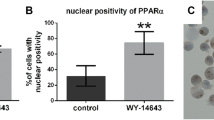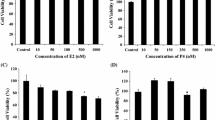Abstract
Peroxisome proliferator-activated receptor γ (PPARγ) is a nuclear receptor that can be activated by natural ligands such as 15-deoxy-delta(12,14)-prostaglandin J2 (15d-PGJ(2)) as well as synthetic drugs such as thiazolidinediones. The treatment of human breast cancer cell lines with PPARγ agonists is known to have antiproliferative effects but the role of PPARγ activation in the process remains unclear. In the present study, we investigated the effects of four PPARγ agonists, Rosiglitazone (RGZ), Ciglitazone (CGZ), Troglitazone (TGZ) and the natural agonist 15d-PGJ(2), on estrogen receptor alpha (ERα) signalling pathway in two hormone-dependent breast cancer cell lines, MCF-7 and ZR-75-1. In both of them, TGZ, CGZ and 15d-PGJ(2) induced an inhibition of ERα signalling associated with the proteasomal degradation of ERα. ZR-75-1 cells were more sensitive than MCF-7 cells to these compounds. Treatments that induced ERα degradation inhibited cell proliferation after 24 h. In contrast, 24 h exposure to RGZ, the most potent activator of PPARγ disrupted neither ERα signalling nor cell proliferation. 9-cis retinoic acid never potentiated the proteasomal degradation of ERα. PPARγ antagonists (T0070907, BADGE and GW 9662) did not block the proteolysis of ERα in MCF-7 and ZR-75-1 cells treated with TGZ. ERα proteolysis still occurred in case of PPARγ silencing as well as in case of treatment with the PPARγ-inactive compound Δ2-TGZ, demonstrating a PPARγ-independent mechanism. The use of thiazolidinedione derivatives able to trigger ERα degradation by a PPARγ-independent pathway could be an interesting tool for breast cancer therapy.











Similar content being viewed by others
References
Mangelsdorf DJ, Thummel C, Beato M et al (1995) The nuclear receptor superfamily: the second decade. Cell 83:835–839
Isseman I, Green S (1990) Activation of a member of the steroid hormone receptor superfamily by peroxisome proliferators. Nature 347:645–650
Kliewer SA, Forman BM, Blumberg B et al (1994) Differential expression and activation of a family of murine peroxisome proliferators-activated receptors. Proc Natl Acad Sci USA 91:7355–7359
Dreyer C, Krey G, Keller H et al (1992) Control of the peroxisomal beta-oxidation pathway by a novel family of nuclear hormone receptors. Cell 68:879–887
Issemann I, Prince RA, Tugwood JD et al (1993) The retinoid X receptor enhances the function of the peroxisome proliferator activated receptor. Biochimie 75:251–256
Mangelsdorf DJ, Evans RM (1995) The R × R heterodimers and orphan receptors. Cell 83:841–850
McKenna NJ, O’Malley BW (2002) Minireview: nuclear receptor coactivators-an update. Endocrinology 43:2461–2465
Yang W, Rachez C, Freedman LP (2000) Discrete roles for peroxisome proliferator-activated receptor gamma and retinoid X receptor in recruiting nuclear receptor coactivators. Mol Cell Biol 20:8008–8017
Thoennes SR, Tate PL, Price TM et al (2000) Differential transcriptional activation of peroxisome proliferator-activated receptor gamma by omega-3 and omega-6 fatty acids in MCF-7 cells. Mol Cell Endocrinol 160:67–73
Forman BM, Tontonoz P, Chen J et al (1995) 15-Deoxy-delta 12, 14-prostaglandin J2 is a ligand for the adipocyte determination factor PPAR gamma. Cell 83:803–812
Kliewer SA, Lenhard JM, Willson TM et al (1995) A prostaglandin J2 metabolite binds peroxisome proliferator-activated receptor gamma and promotes adipocyte differentiation. Cell 83:813–819
Lehmann JM, Lenhard JM, Oliver BB et al (1997) Peroxisome proliferator-activated receptors alpha and gamma are activated by indomethacin and other non-steroidal anti-inflammatory drugs. J Biol Chem 272:3406–3410
Spiegelman BM (1998) PPAR-gamma: adipogenic regulator and thiazolidinedione receptor. Diabetes 47:507–514
Kim KY, Kim SS, Cheon HG (2006) Differential anti-proliferative actions of peroxisome proliferator-activated receptor-gamma agonists in MCF-7 breast cancer cells. Biochem Pharmacol 72:530–540
Nwankwo JO, Robbins ME (2001) Peroxisome proliferator-activated receptor-gamma expression in human malignant and normal brain, breast and prostate-derived cells. Prostaglandins Leukot Essent Fatty Acids 64:241–245
Elstner E, Muller C, Koshizuka K et al (1998) Ligands for peroxisome proliferators-activated receptor gamma and retinoic acid receptor inhibit growth and induce apoptosis of human breast cancer cells in vitro and in BNX mice. Proc Natl Acad Sci 95:8806–8811
Mueller E, Sarraf P, Tontonoz P et al (1998) Terminal differentiation of human breast cancer through PPARγ. Mol Cell 1:465–470
Mehta RG, Williamson E, Patel MK et al (2000) A ligand of peroxisome proliferator-activated receptor gamma, retinoids, and prevention of preneoplastic mammary lesions. J Natl Cancer Inst 92:418–423
Fenner MH, Elstner E (2005) Peroxisome proliferator-activated receptor-g ligands for the treatment of breast cancer. Expert Opin Investig Drugs 14:557–568
Yin F, Wakino S, Liu Z et al (2001) TGZ inhibits growth of MCF-7 breast carcinoma cells by targeting G1 cell cycle regulators. Biochem Biophys Res Commun 286:916–922
Goetze S, Xi XP, Kawano H et al (1999) PPAR gamma-ligands inhibit migration mediated by multiple chemoattractants in vascular smooth muscle cells. J Cardiovasc Pharmacol 33:798–806
Xin X, Yang S, Kowalski J et al (1999) Peroxisome proliferator-activated receptor gamma ligands are potent inhibitors of angiogenesis in vitro and in vivo. J Biol Chem 274:9116–9121
Burstein HJ, Demetri GD, Mueller E et al (2003) Use of the peroxisome proliferator-activated receptor (PPAR) gamma ligand TGZ as treatment for refractory breast cancer: a phase II study. Breast Cancer Res Treat 79:391–397
Yee LD, Williams N, Wen P et al (2007) Pilot study of rosiglitazone therapy in women with breast cancer:effects of short-term therapy on tumor tissue and serum marker. Clin Cancer Res 13:246–252
Nelson NJ (2006) Migrant studies aid the search for factors linked to breast cancer risk. J Natl Cancer Inst 98:436–438
Massarweh S, Schiff R (2006) Resistance to endocrine therapy in breast cancer: exploiting estrogen receptor/growth factor signalling crosstalk. Endocr Relat Cancer 13:S15–S24
Wang X, Kilgore MW (2002) Signal cross-talk between estrogen receptor alpha and beta and the peroxisome proliferator-activated receptor gamma1 in MDA-MB-231 and MCF-7 breast cancer cells. Mol Cell Endocrinol 194:123–133
Bonofiglio D, Gabriele S, Aquila S et al (2005) Estrogen receptor alpha binds to peroxisome proliferator-activated receptor response element and negatively interferes with peroxisome proliferator-activated receptor gamma signalling in breast cancer cells. Clin Cancer Res 11:6139–6147
Huang JW, Shiau CW, Yang YT et al (2005) Peroxisome proliferator-activated receptor γ-independent ablation of cyclin D1 by Thiazolidinediones and their derivatives in breast cancer cells. Mol Pharmacol 67:1342–1348
Shiau CW, Yang CC, Kulp SK et al (2005) Thiazolidenediones mediate apoptosis in prostate cancer cells in part through inhibition of Bcl-xL/Bcl-2 functions independently of PPARgamma. Cancer Res 65:1561–1569
Turturro F, Friday E, Fowler R et al (2004) TGZ acts on cellular pH and DNA synthesis through a peroxisome proliferator-activated receptor γ-independent mechanism in breast cancer-derivated cell lines. Clin Cancer Res 10:7022–7030
Clay CE, Monjazeb A, Thorburn J et al (2002) 15-Deoxy-delta 12,14-prostaglandin J2-induced apoptosis does not require PPARgamma in breast cancer cells. J Lipid Res 43:1818–1828
Pandhare J, Cooper SK, Phang JM (2006) Proline oxidase, a proapoptotic gene, is induced by TGZ. Evidence for both peroxisome proliferator-activated receptor γ-dependent and -independent mechanisms. J Biol Chem 281:2044–2052
Seargent JM, Yates EA, Gill JH (2004) GW9662, a potent antagonist of PPARgamma, inhibits growth of breast tumour cells and promotes the anticancer effects of the PPARgamma agonist rosiglitazone, independently of PPARgamma activation. Br J Pharmacol 143:933–937
Wang T, Xu J, Yu X et al (2006) Peroxisome proliferator-activated receptor gamma in malignant diseases. Crit Rev Oncol Hematol 58:1–14
Qin C, Burghardt R, Smith R et al (2003) Peroxisome proliferators-activated receptor-γ agonists induce proteasome-dependent degradation of cyclin D1 and estrogen receptor α in MCF-7 breast cancer cells. Cancer Res 63:958–964
Suzuki T, Hayashi S, Miki Y et al (2006) Peroxisome proliferator-activated receptor γ in human breast carcinoma: a modulator of estrogenic actions. Endocr Relat Cancer 13:233–250
Kim HJ, Kim JY, Meng Z et al (2007) 15-deoxy-Delta 12,14-prostaglandin J2 inhibits transcriptional activity of estrogen receptor-alpha via covalent modification of DNA-binding domain. Cancer Res 67:2595–2602
Boschi D, Tron GC, Lazzarato L et al (2006) NO-Donor phenols: a new class of products endowed with antioxidant and vasodilator properties. J Med Chem 49:2886–2897
Huang JW, Shiau CW, Yang J et al (2006) Development of small-molecule cyclin D1-ablative agents. J Med Chem 49:4684–4689
Fazzari A, Catalano MG, Comba A et al (2001) The control of progesterone receptor expression in MCF-7 breast cancer cells: effects of estradiol and sex hormone-binding globulin (SHBG). Mol Cell Endocrinol 172:31–36
Okubo T, Yokoyama Y, Kano K et al (2001) ER-dependent estrogenic activity of parabens assessed by proliferation of human breast cancer MCF-7 cells and expression of ERalpha and PR. Food Chem Toxicol 39:1225–1232
Morosetti R, Park DJ, Chumakov AM et al (1997) A novel, myeloid transcription factor, C/EBP epsilon, is upregulated during granulocytic, but not monocytic, differentiation. Blood 90:2591–2600
Weng JR, Chen CY, Pinzone JJ et al (2006) Beyond peroxisome proliferator-activated receptor gamma signalling: the muti-facets of the antitumor effect of thiazolidinediones. Endocr Relat Cancer 13:401–413
Leclercq G, Lacroix M, Laïos I et al (2006) Estrogen receptor alpha: impact of ligands on intracellular shuttling and turnover rate in breast cancer cells. Curr Cancer Drug Targets 6:39–64
Elstner E, Williamson EA, Zang C et al (2002) Novel therapeutic approach: ligands for PPAR-γ and retinoid receptors induce apoptosis in bcl-2-positive human breast cancer cells. Breast Cancer Res Treat 74:155–165
Etique N, Flament S, Lecomte J et al (2007) Ethanol-induced ligand-independent activation of ERα mediated by cyclic AMP/PKA pathway: an in vitro study on MCF-7 breast cancer cells. Int J Oncol 31(6):1509–1518
Keller H, Givel F, Perroud M et al (1995) Signaling cross-talk between peroxisome proliferator-activated receptor/retinoid × receptor and estrogen receptor through estrogen response elements. Mol Endocrinol 9:794–804
Wolf DH, Hilt W (2004) The proteasome: a proteolytic nanomachine of cell regulation and waste disposal. Biochim Biophys Acta 1695:19–31
Callige M, Richard-Foy H (2006) Ligand-induced estrogen receptor alpha degradation by the proteasome: new actors? Nucl Recept Signal 4:e004
Henke BR, Blanchard SG, Brackeen MF et al (1998) N-(2-Benzoylphenyl)-L-tyrosine PPARgamma agonists. 1. Discovery of a novel series of potent antihyperglycemic and antihyperlipidemic agents. J Med Chem 41:5020–5036
Allred CD, Kilgore MW (2005) Selective activation of PPARgamma in breast, colon, and lung cancer cell lines. Mol Cell Endocrinol 235:21–29
Qin C, Morrow D, Stewart J et al (2004) A new class of peroxisome proliferator-activated receptor gamma (PPARgamma) agonists that inhibit growth of breast cancer cells: 1,1-Bis(3′-indolyl)-1-(p-substituted phenyl)methanes. Mol Cancer Ther 3(3):247–260
Lea MA, Sura M, Desbordes C (2004) Inhibition of cell proliferation by potential peroxisome proliferator-activated receptor (PPAR) gamma agonists and antagonists. Anticancer Res 24:2765–2771
Schaefer KL, Takahashi H, Morales VM et al (2006) PPARgamma inhibitors reduce tubulin protein levels by a PPARgamma, PPAR delta and proteasome-independent mechanism, resulting in cell cycle arrest, apoptosis and reduced metastasis of colorectal carcinoma cells. Int J Cancer 120:702–713
Keelan J, Helliwell R, Nijmeijer B et al (2001) 15-deoxy-delta12,14-prostaglandin J2-induced apoptosis in amnion-like WISH cells. Prostaglandins Other Lipid Mediat 66:265–282
Bonofiglio D, Aquila S, Catalano S et al (2006) Peroxisome proliferator-activated receptor-gamma activates p53 gene promoter binding to the nuclear factor-kappaB sequence in human MCF7 breast cancer cells. Mol Endocrinol 20:3083–3092
Talbert DR, Allred CD, Zaytseva YY et al (2007) Transactivation of ERalpha by RZG induces proliferation in breast cancer cells. Breast Cancer Res Treat (in press)
Acknowledgements
This work was supported by grants of the ‘Université Henri Poincaré (BQR)’, of the ‘Association pour la Recherche sur le Cancer’, of the ‘Ligue Contre le Cancer, comité de la Haute-Marne’ and of ‘Canceropole Grand Est’. Julie Lecomte is recipient of a grant of the ‘Ligue Contre le Cancer, comité de la Haute-Marne’. We would like to thank SANOFI AVENTIS for a studentship to Stéphane Salamone. We also thank Romain Hany, Martine Chillet, Brigitte Fernette and Sandrine Adach for technical assistance. The pPPRE3tkLuc construct and the human PPARγ expression vector were generous gifts of Pr. Philippe Becuwe and Dr. Lionel Domenjoud respectively.
Author information
Authors and Affiliations
Corresponding author
Rights and permissions
About this article
Cite this article
Lecomte, J., Flament, S., Salamone, S. et al. Disruption of ERα signalling pathway by PPARγ agonists: evidences of PPARγ-independent events in two hormone-dependent breast cancer cell lines. Breast Cancer Res Treat 112, 437–451 (2008). https://doi.org/10.1007/s10549-007-9886-z
Received:
Accepted:
Published:
Issue Date:
DOI: https://doi.org/10.1007/s10549-007-9886-z




